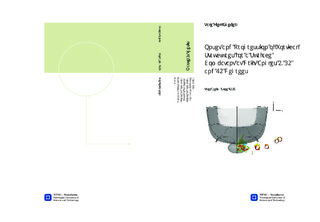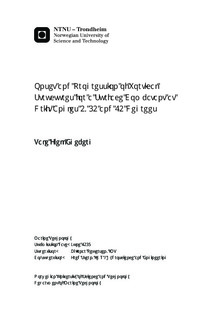| dc.description.abstract | The onset on progression of vortical structures of the ship model DTMB 5512 (geosym of DTMB5415) has been examined for drift angles -1, 10 and 20 degrees, by means of tomographic particle image velocimetry. The drift angle -1 degrees, which is close to the neutral angle, was chosen instead of 0 degrees, when it was discovered that 0 degrees gave asymmetry in the flow. The DTMB 5415 is preliminary design for a surface combatant for the US Navy, and is equipped with a transom stern and a sonar dome in the bow. Two major streamwise vortices are detected for -1 degrees, the sonar dome vortex (SDV) and the fore-body keel vortex (FBKV). There is also a vortex forming on the bilge keel, called the bilge-keel vortex (BKV). For 10 degrees drift angle, the main flow feature is the SDV. One vortex forms on either side of the sonar dome, and merge between X/Lpp$=0.120 and X/Lpp=0.200. A BKV is seen on the leeward side at X/Lpp=0.600, but merges quickly with the SDV. At X/Lpp=0.935 the windward BKV has drifted close to the centreline, and in addition a vortex has formed on the after-body. The major vortices at drift angle 20 degrees are the SDV, FBKV and windward FBKV. Only one SDV is observed, and it is assumed that the windward SDV dissipates rapidly because of the strain from the strong crossflow at this drift angle. The inception the the FBKV's is around X/Lpp=0.200, and it is assumed that they either dissipate or merge with the stronger SDV at some point between X/Lpp=0.400 and X/Lpp=0.600. Vortices form on both bilge keels at X/Lpp=0.400. The leeward BKV persists until somewhere between X/Lpp=0.600 and X/Lpp=0.800. At X/Lpp=0.800 the windward BKV has drifted close to the centreline, and we see the early formation of a vortex on the after-body (after-body keel vortex, ABKV) . The ABKV still persists at X/Lpp=0.935.Detailed analysis of the 3D mean flow field is performed for X/Lpp=0.400, in order to determine the influence of drift angle on the turbulent kinetic energy (TKE), Reynolds stresses, strains, vorticity and vortical structures. The magnitude of strains, stresses, and thus TKE, as well as vorticity increase with the drift angle. For the two largest drift angles, the maxima of strains and stresses are in the vicinity of the SDV. For -1 degrees, the proximity of the hull influences the stress and strain field. Iso-surfaces of Q>0 and lambda2 <0 are used to identify vortical structures. There seems to be little difference between them when computing mean values, although lambda2 appears to be more sensitive to the measurement noise close to the model surface. For the instantaneous iso-surfaces, lambda2 seems to capture more small vortex filaments, but the major trends are the same.Frequency analysis of the SDV of 20 degrees at measurement stations X/Lpp=0.060 - 0.600 reveal a dominant frequency of approximately 3[Hz] for the spanwise velocity components, but no dominant frequency for the streamwise component. | nb_NO |

